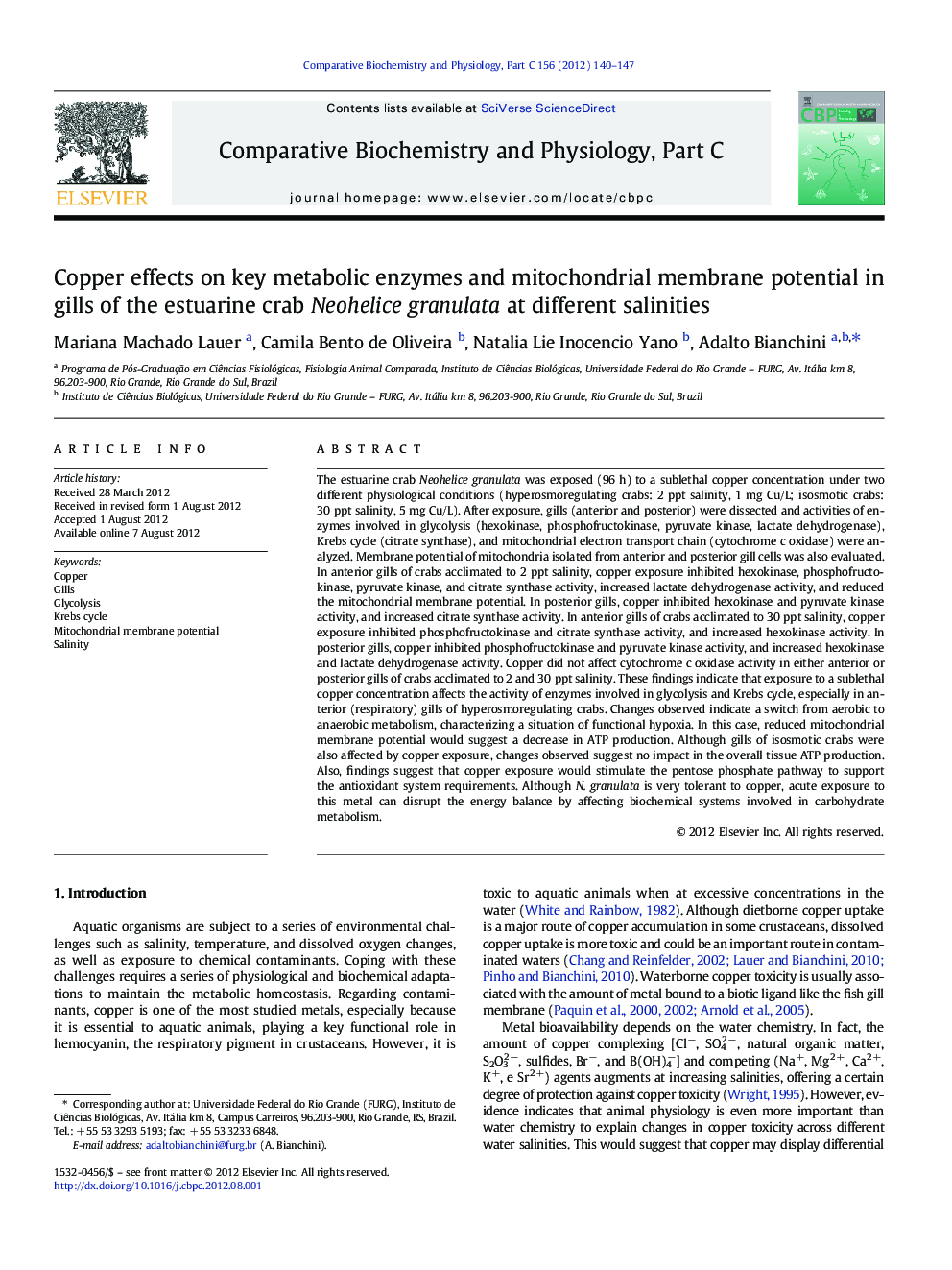| کد مقاله | کد نشریه | سال انتشار | مقاله انگلیسی | نسخه تمام متن |
|---|---|---|---|---|
| 8319207 | 1539298 | 2012 | 8 صفحه PDF | دانلود رایگان |
عنوان انگلیسی مقاله ISI
Copper effects on key metabolic enzymes and mitochondrial membrane potential in gills of the estuarine crab Neohelice granulata at different salinities
دانلود مقاله + سفارش ترجمه
دانلود مقاله ISI انگلیسی
رایگان برای ایرانیان
کلمات کلیدی
موضوعات مرتبط
علوم زیستی و بیوفناوری
بیوشیمی، ژنتیک و زیست شناسی مولکولی
زیست شیمی
پیش نمایش صفحه اول مقاله

چکیده انگلیسی
The estuarine crab Neohelice granulata was exposed (96Â h) to a sublethal copper concentration under two different physiological conditions (hyperosmoregulating crabs: 2Â ppt salinity, 1Â mg Cu/L; isosmotic crabs: 30Â ppt salinity, 5Â mg Cu/L). After exposure, gills (anterior and posterior) were dissected and activities of enzymes involved in glycolysis (hexokinase, phosphofructokinase, pyruvate kinase, lactate dehydrogenase), Krebs cycle (citrate synthase), and mitochondrial electron transport chain (cytochrome c oxidase) were analyzed. Membrane potential of mitochondria isolated from anterior and posterior gill cells was also evaluated. In anterior gills of crabs acclimated to 2Â ppt salinity, copper exposure inhibited hexokinase, phosphofructokinase, pyruvate kinase, and citrate synthase activity, increased lactate dehydrogenase activity, and reduced the mitochondrial membrane potential. In posterior gills, copper inhibited hexokinase and pyruvate kinase activity, and increased citrate synthase activity. In anterior gills of crabs acclimated to 30Â ppt salinity, copper exposure inhibited phosphofructokinase and citrate synthase activity, and increased hexokinase activity. In posterior gills, copper inhibited phosphofructokinase and pyruvate kinase activity, and increased hexokinase and lactate dehydrogenase activity. Copper did not affect cytochrome c oxidase activity in either anterior or posterior gills of crabs acclimated to 2 and 30Â ppt salinity. These findings indicate that exposure to a sublethal copper concentration affects the activity of enzymes involved in glycolysis and Krebs cycle, especially in anterior (respiratory) gills of hyperosmoregulating crabs. Changes observed indicate a switch from aerobic to anaerobic metabolism, characterizing a situation of functional hypoxia. In this case, reduced mitochondrial membrane potential would suggest a decrease in ATP production. Although gills of isosmotic crabs were also affected by copper exposure, changes observed suggest no impact in the overall tissue ATP production. Also, findings suggest that copper exposure would stimulate the pentose phosphate pathway to support the antioxidant system requirements. Although N. granulata is very tolerant to copper, acute exposure to this metal can disrupt the energy balance by affecting biochemical systems involved in carbohydrate metabolism.
ناشر
Database: Elsevier - ScienceDirect (ساینس دایرکت)
Journal: Comparative Biochemistry and Physiology Part C: Toxicology & Pharmacology - Volume 156, Issues 3â4, November 2012, Pages 140-147
Journal: Comparative Biochemistry and Physiology Part C: Toxicology & Pharmacology - Volume 156, Issues 3â4, November 2012, Pages 140-147
نویسندگان
Mariana Machado Lauer, Camila Bento de Oliveira, Natalia Lie Inocencio Yano, Adalto Bianchini,